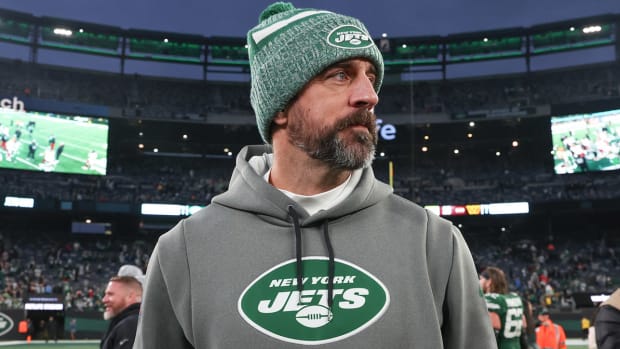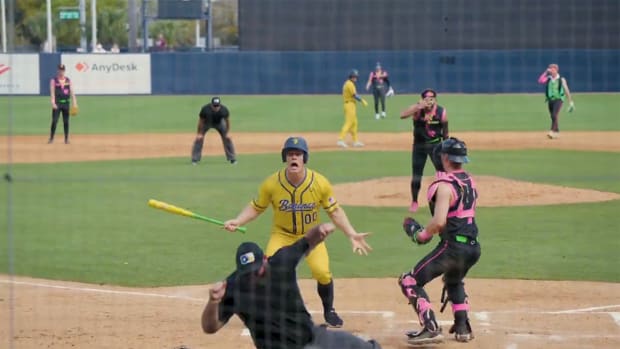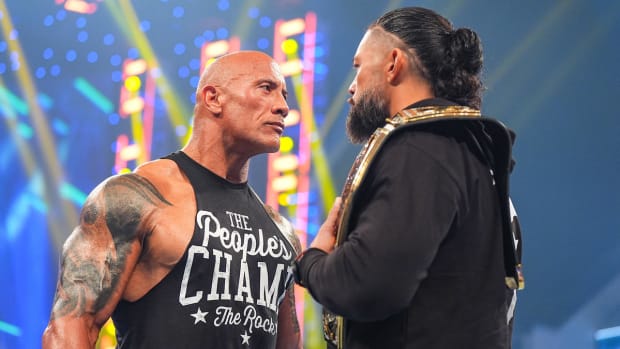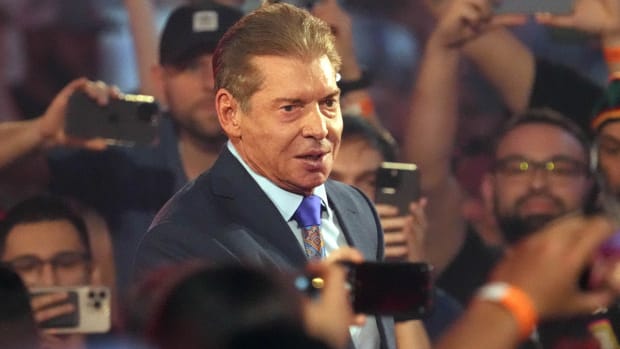‘SummerSlam’ Was Just the Start of WWE’s Fascinating Next Era
After the seismic shift in WWE with the departure of Vince McMahon over sexual misconduct allegations, Saturday’s SummerSlam was the first test of the new regime.
The first major show was a success, both artistically and aesthetically, with 40,117 fans at Nissan Stadium in Nashville. The visuals were impressive, giving the show a look that is different from its weekly television shows and all but its biggest major events.
The show was long on special effects, such as Brock Lesnar using a tractor to tip over the wrestling ring in the main event, as well as a match with outside celebrity Logan Paul.
What has happened in recent months has been a roller-coaster ride. Vince McMahon’s daughter, Stephanie, and son-in-law, Paul “Triple H” Levesque, are now heading up the wrestling side of things. For close to two decades, this was the expected result at some point in time. Pro wrestling may last forever, but even Vince at some point was not going to be there to steer the ship. The question was always when this would happen. The nature of how and when it came was a surprise, but the succession plan has been talked about seemingly forever.
But things changed greatly over the past year. Levesque had his vision of NXT completely overhauled by those above him, which was a major loss of power in the company. Then he suffered a major heart issue. Some of the talent, and others behind the scenes, who he had picked for “his team,” were let go.
On May 19, Stephanie, the chief brand officer, announced she was taking a leave of absence. It was said at the time the leave was going to be lengthy, and on June 6, a replacement was named. Catherine Newman came from Manchester United media, and was hired as executive vice president and head of marketing.
Then, on June 24, when her father stepped down as CEO after reports he had paid off a woman working in the company in exchange for an NDA to cover up their relationship, Stephanie was named interim CEO. Her father stepped down from the position pending an investigation of the charges but remained head of creative, which from a wrestling fan and wrestler perspective, is the most important position in the company.
At the July 2 Money in the Bank pay-per-view show in Las Vegas, Vince McMahon assured talent he was going nowhere.
Then on July 22, he announced he was retiring, which was actually a resignation due to more stories from this past resurfacing. This meant for the first time in more than 40 years, Vince was not in charge of the creative direction. Somebody else will decide which wrestlers get hired, which wrestlers get fired, who gets TV time and who doesn’t, who wins, who loses, who is earmarked for stardom and what the story lines are.
With Vince out, Stephanie’s role was no longer interim. She is the co-CEO, with company president Nick Khan as the other co-CEO. Stephanie will be in charge of the wrestling product and promotion of the product seen on television and at the arenas. Levesque was named head of creative, meaning he’s in charge of the stories, talent and contracts, and decides how to push the stars as well as who are the stars. Khan’s role would be to run the business end, negotiating the various television and other distribution deals, as well as hiring and building the nonwrestling side of the front office.
For wrestling fans, the question is, how does the product change and how does it stay the same.
Levesque over the weekend gave no answers, just saying watch and find out.
The show didn’t seem much different from the previous product. Thus far the only notable changes are that Becky Lynch, who had been the company’s biggest female star of the past few years, is going back to being a babyface. She had returned last year after giving birth, and was surprisingly slotted as a heel. It was a mixed bag. On one hand, Bianca Belair was able to ascend to greater popularity with Lynch as her heel adversary. But in doing so, they were fighting the fans at every turn. Lynch was cheered at most shows unless she would insult the fans heavily enough to get her booed. It was constantly fighting the fact the fans wanted to cheer her, so moving her back to babyface made sense.
To do so, he brought in a new women’s heel stable for Raw, consisting of Bayley, Dakota Kai and Io Shirai (now Iyo Sky). They will apparently feud with Lynch and Belair, who made up and hugged after a yearlong program.
Bayley was returning after being out for a year with a torn ACL. Kai was one of the key female stars in NXT, until Levesque no longer had the power over that brand, and then she was fired. Shirai had also been in NXT, the developmental brand, even though she was easily one of the company’s best wrestlers. And it was obvious the decision to include her was last-minute because when she made her entrance at SummerSlam, the video had her name as Io Shirai, and wasn’t even changed to her new ring name. The name change was made because company policy for new people as a general rule is that they don’t want them using a real first or last name, or a previous name they had used earlier in their career. The idea is for the company to own full rights to every name. Shirai (real name Masami Odate) had become a major star in Japan under the Io Shirai name.
The only other immediate change involved Max Dupri. Formerly working under the name LA Knight, as a wrestler in NXT he was known for being a strong talker. He was brought up to SmackDown, not as a wrestler, but as a front man for Maximum Male Models, two wrestlers who had not been used much and had been repackaged doing vignettes where they were modeling types of athletic clothes. After only a few weeks, Vince removed him from that role and replaced him with a supposed sister, Maxxine Dupri, a model who had just started on NXT television. Levesque brought Max Dupri back in his first week on the job.
This decision seems a little more of a mixed bag. Shaun Ricker, who plays Dupri, is far superior as a talker to his “sister” and as the guy who would do the interviews for the male model crew. It appears Maxxine will remain part of the group. However, the group itself has been largely a miss so far. And there was some awareness as this past Friday’s segment, which had been advertised for two weeks, was done backstage rather than in front of the fans in the building.
The Vince McMahon scandal and curiosity over what is next have led to increased curiosity, and both higher television ratings and increased ticket sales at live events the last few weeks.
But, pro wrestling is a marathon, not a sprint. And, long term, there are numerous questions. The economic health of WWE is not one of them. Most of its money comes from guaranteed and contractually increasing rights fees for television and streaming. The current deals expire in late 2024. With WWE TV scoring high ratings, Raw usually wins Monday nights on cable except during football season; SmackDown usually battles for first on network television on Fridays unless there is a major sports event; the feeling is more television stations and streaming properties would like shows that largely guarantee a consistent weekly audience 52 weeks a year.
Levesque, when he did run NXT, pushed a variety of different types of wrestlers. He and his chief lieutenant, William Regal, signed up the top independent wrestlers they could get from around the world, along with recruiting high-level athletes who had never done pro wrestling and training them from scratch. Because the independent wrestlers were so much more advanced, they stood out in NXT and became the standout characters.
When Levesque lost power, and the company fired Regal, who now works for rival AEW, the company went heavily in a new direction. The focus has been on recruiting college athletes who are good looking, and preferably, already had strong social media followings. The idea was getting men and women who look like stars and train them to be pro wrestlers.
This led to a dichotomy with WWE’s main rival, AEW, which concentrated on signing the best independent wrestlers, with the idea of putting great matches on television. AEW also had its projects, notably 7'3" India native Satnam Singh, the uniquely muscular former Jacksonville University women’s basketball player Jade Cargill and Olympic bronze medalist boxer Anthony Ogogo. But they are the exceptions. For a time it appeared that the marathon would be able to find out which strategy ends up the most effective.
But with Levesque in charge, WWE is expected to revert back, to both recruiting college athletes and also attempting to sign the most talented independent wrestlers. But that has not been a direction change announced internally.
It also appears Levesque and Stephanie McMahon will only be more combative with AEW. While not announced yet, an internal memo at WWE noted that it will be putting an NXT special Sept. 4 on Peacock. There is no chance that date, the same date as AEW’s next pay-per-view show, All Out, is simply a coincidence. Ironically that is the battle plan Vince constantly used in the 1980s, particularly doing major events when Jim Crockett Promotions would have pay-per-view shows scheduled. In fact, two of WWE’s traditions, the Royal Rumble and Survivor Series first debuted as counterprogramming rival events.
But since NXT, which had gone head-to-head with AEW on television, moved from Wednesday to Tuesday after losing in the 18- to 49-year-old demographic rating 74 out of 75 weeks and one attempt to extend SmackDown to where it would go head-to-head with AEW Rampage on a Friday, Vince had not done counterprogramming.
Levesque’s role was to destroy AEW on television, and it seemed like history would say he lost in the marathon.
But in fact, the marathon has just gotten started. The belief is Levesque will have a wider view on who can be a star than his mentor Vince. But that remains to be seen, since what he did for a smaller brand doesn’t necessarily mean he will adopt the same strategy for a bigger brand aimed at a wider audience. Many feel the logical extension of this is that key talent will leave AEW when their contracts expire, but we will see how this plays out over the next few years.
A lot of AEW’s top stars (due to their size as well as their faster-paced, harder-hitting and more acrobatic ring styles and their heavier emphasis on in-ring skills and less on talking) were not Vince’s cup of tea when it came to the type of wrestlers he believed could be headliners. Those performers were aware of it, and AEW became their destination. But if WWE under Levesque reevaluates the idea of who can headline, that changes both the WWE’s product and also greatly affects AEW.
If this is the case, and WWE, with its $1.1 billion in annual revenues, heavily goes after AEW talent when their contracts are up, that will make major changes in the landscape. The beneficiaries of this change in the competition look to be the top wrestlers—and, at least in the short term, the fans as well.
More From Wrestling Observer:




